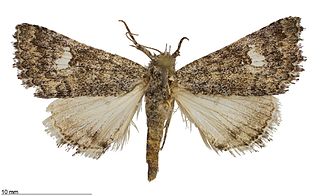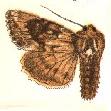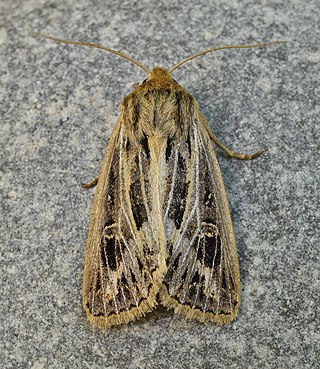
Apamea remissa, the dusky brocade, is a species of moth of the family Noctuidae. It is distributed throughout Europe and Turkey, ranging across the Palearctic realm to Siberia, Manchuria and Japan. It has also been reported from Alaska.

Apamea sordens, the rustic shoulder-knot or bordered apamea, is a moth of the family Noctuidae. The species was first described by Johann Siegfried Hufnagel in 1766. It is distributed throughout Europe, east across the Palearctic to Central Asia and to China and Japan. It also occurs in North America.

Apamea is a genus of moths in the family Noctuidae first described by Ferdinand Ochsenheimer in 1816.

Drasteria is a genus of moths in the family Erebidae.

Heteranassa is a monotypic moth genus in the family Erebidae described by J. B. Smith in 1899. Its only species, Heteranassa mima, was first described by Leon F. Harvey in 1876. It is found in warm, arid habitats in North America from California to Texas, northward to Oklahoma, and south as far as Oaxaca in Mexico.

Apamea centralis is a moth of the family Noctuidae first described by Smith in 1891. It is native to North America, where its range extends from California to Alberta.

Apamea cogitata, the thoughtful apamea, is a moth of the family Noctuidae. It is native to North America, where it can be found across Canada from Newfoundland to British Columbia and the Northwest Territories, and in the western United States to California.
Apamea robertsoni is a moth of the family Noctuidae. It was described from Southern California in 2006.
Apamea bernardino is a moth of the family Noctuidae. It is known only from the San Bernardino Mountains of California, where it lives in coniferous forests above 2000 meters in elevation. It was first described in 2000 from a specimen collected at Barton Flats.
Apamea longula is a moth of the family Noctuidae first described by Augustus Radcliffe Grote in 1879. It is found in western North America, mostly from California to the Great Plains. There are also a few records from areas north, including Alberta, Yukon, and Alaska.

Apamea niveivenosa, the snowy-veined apamea, is a moth of the family Noctuidae. The species was first described by Augustus Radcliffe Grote in 1879. It is native to northern North America, where it can be found across Canada and south to California.

Apamea scoparia is a moth of the family Noctuidae first described by Kauri Mikkola, Tomas Mustelin and J. Donald Lafontaine in 2000. It is one of the most common and widespread North American Apamea, being distributed from Newfoundland and Labrador to Alaska and British Columbia, and south to California and Arizona.

Apamea spaldingi, or Spalding's Quaker, is a moth of the family Noctuidae. The species was first described by John Bernhardt Smith in 1909. It is native to interior western North America.

Apamea apamiformis, known by the common names rice worm moth, riceworm, and wild rice worm, is a moth of the family Noctuidae. It is found in North America, including Wisconsin, New York, Minnesota and eastern Canada, with imperiled or critically imperiled populations in Maryland and Indiana, respectively, and a vulnerable population in New Jersey.
Apamea inebriata, the drunk apamea, is a moth of the family Noctuidae. It is found along the east coast of North America from Nova Scotia to North Carolina.

Apamea acera is a moth of the family Noctuidae. It is native to western North America, where it can be found from British Columbia south to California and east to Utah.

Apamea zeta is a moth of the family Noctuidae. It has a Holarctic distribution, and can be found throughout the Northern Hemisphere. It occurs throughout Europe and the northern half of North America.

Apamea albina is a moth of the family Noctuidae. It is native to California and Oregon in the United States. It lives in forests and oak savanna on serpentine soils.

Apamea rubrirena is a moth of the family Noctuidae.

Apamea quinteri is a species of cutworm or dart moth in the family Noctuidae. It is found in North America.











